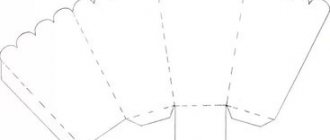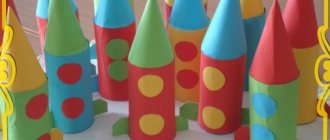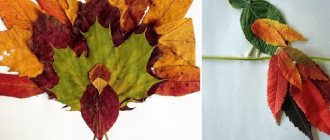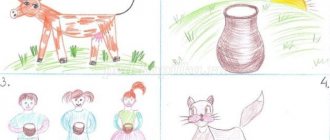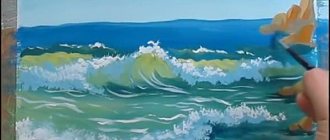Master class “Craft from cardboard and paper “Round Dance of Friendship”
Tatiana Voronina
Master class “Craft from cardboard and paper “Round Dance of Friendship”
I suggest making a craft using bright cardboard and colored office paper as a base. I made this craft with my child for an ecology competition. You can use it in your work to introduce children to ecology .
First of all, on blue cardboard, draw a plate of the desired size along the contour and cut out a circle. This is our planet - Earth. Cut out continents from green paper.
We glue the continents as shown in the photo. The basis for our craft is ready.
I printed out boy and girl templates and face templates. For a girl there is a regular circle, for a boy with ears.
Using templates, cut out three figures of a boy and three figures of a girl from colored office paper.
And the little ones from light-colored paper: two girls and two boys.
Peacekeeping action “Garland of Friendship”. Master class on making a doll
Tatiana Khomusko
Peacekeeping action “Garland of Friendship”. Master class on making a doll
Good afternoon, colleagues. At the beginning of November I turned my attention. for “ Garland of Friendship campaign , and since I am a creative person, I was interested in this. I invited the children to take part, everyone unanimously agreed . From the beginning, I explained to the children why we would make dolls. what is the purpose of this action ? While we were making dolls, I told the children about the history of dolls. She gave examples of the use of these dolls. The children were very interested in the fact that they could be used as amulets. We discussed for a long time what it means to be friends . I really liked the reasoning of my guys. Somehow, suddenly, it immediately became clear that they had already grown up. Many of them said that they would ask their parents to make one more squash at home. When the parents came to pick up their children, I invited them to take part. Many agreed, but asked to show how to make a doll . This is the master class I prepared for parents.
1. To make a sledgehammer we will need: scissors, fabric of different sizes and types. A large flap for the doll , a smaller flap for the hands. We also take threads (yarn, floss, iris)
for decorating the head, torso, arms. Any decorations.
2. Take the flap for the doll , fold it inward on both sides, then fold it again towards the center. Then we put one side on the other.
3.Next step: bend it in half and take a long thread to highlight the head. We tie the thread on the reverse side. you can make several turns. Leave the ends of the thread.
4. Then we make hands using the same principle. We shape the hands and tie them with short threads.
We place our hands in the middle of the body.
5. Take the ends of the thread and make a cross on the waist. Let's tie it up.
6. The cube doll is almost ready. The threads can be cut, but you can also leave them for attaching the next dolls.
Pedagogical guidelines for organizing classes
In the preparatory group, the main goal of the work is to introduce children to beauty, to cultivate love and interest in fine arts and creativity, aesthetics and a sense of color and compositional harmony.
During appliqué classes, children aged 6–7 years cut out paper and glue cut out parts or whole figures. The main artistic means in applique are color and expressiveness of the contour. Silhouette cutting occupies a significant place. An interesting job that develops cutting skills can be transferring a form from life.
The process of evaluating work becomes important in the preschool group. The teacher must teach children to pay attention to shape, color scheme, arrangement of figures, as well as plot and compositional solutions. In addition, such creative analysis develops analytical skills, speech, the ability to express one’s opinion, and outlook. Each lesson should end with an assessment of children's work with the help of leading questions from the teacher.
Preparation for a lesson on a collective application on the theme “Festive round dance”
Thematic variations
An application on the theme “Festive round dance” opens up broad prospects for the manifestation of imagination and creative ideas for both the teacher and the children. The lesson can be timed to coincide with a calendar holiday: Children's Day, National Unity Day. Pedagogical ingenuity will help the teacher come up with holiday events that are not on the calendar: the arrival of spring, the holiday of Russian costume, the holiday of Russian nesting dolls, the holiday of the unification of all the children of the planet. An application on this topic can be either collective or individual. However, collective creativity helps unite the children's team, develop cognitive interest, as well as the desire to achieve a common creative idea and result.
Using different techniques
In the preparatory group, work on this topic is complicated with the help of decoration techniques and the use of traditional and non-traditional appliqué techniques or their creative combination. Depending on the level of general training of the children, the teacher may limit himself to traditional techniques and invite the children to trace a figure using a template and cut it out from a whole sheet of paper or perform a symmetrical appliqué. Non-traditional techniques are an excellent means of developing imagination, inspiration, children's talent and inquisitiveness in creating future masterpieces, not only in appliqué classes. Among the non-traditional techniques that a teacher can use in a lesson on the topic “Festive Round Dance” are the following: quilling (creating compositions from strips of paper swirled in spirals), trimming (can be used as a decoration technique along with symmetrical or silhouette appliqué), appliqué from corrugated paper or fabric.
Design options for the basis for a round dance
The basis for the arrangement of the round dance from children's works is made by the teacher in advance independently, if it will be the subject of a preliminary conversation at the beginning of the lesson, and according to the teacher's plan, the children should not know about the topic of the upcoming lesson. Another option could be to work together with children. The teacher can attract a small group of children of 3-4 people to work together on the workpiece. This type of work can become a logical continuation of a topic that was discussed with the children in other classes, and the children know what lesson they are preparing for and what it is dedicated to.
The basis for placing a round dance from children's works directly depends on the topic of the lesson. Examples include the following ideas:
- “Round dance of friendship” - an image of the globe in the center of a large sheet of paper and a round dance of boys and girls from different countries, in different costumes, of different nationalities. You can add elements of drawing and make prints of colored children’s hands around the round dance.
- “Spring Round Dance” - an image of a Spring girl in a bright green sundress, a wreath of the first spring flowers in the center of a large sheet of paper, and a round dance of girls in decorated sundresses. Can be complemented with flowers and butterflies made of corrugated paper.
- “Round dance of Russian beauties” - an image of Russian birch trees on a sunny day (you can use non-traditional drawing or appliqué techniques) and a round dance of girls in Russian sundresses.
- “Winter has come” - an image of a Christmas tree covered with snow, in the center of a light blue tinted paper, and around there is a round dance of snowmen. You can make snow on the Christmas tree using the cutting appliqué technique.
- “Golden Autumn” is an image of an Autumn girl in a golden sundress, decorated with the gifts of nature - leaves, berries - in the center of a large sheet of paper and around a round dance of girls in yellow, orange and red sundresses, decorated with autumn motifs or according to the children's design. You can decorate the remaining space with the help of falling leaves, using different drawing or applique techniques (for example, dry leaves from a herbarium).
